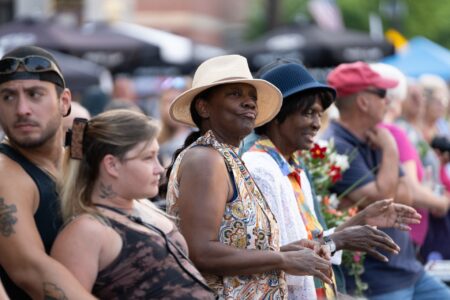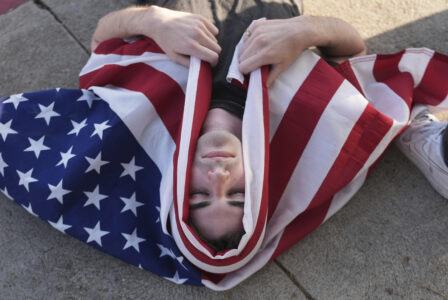Dystance4Dystonia: Merrimack woman continues to ‘distance’ herself from symptoms of dystonia

Telegraph photo by DEAN SHALHOUP Participants in Sunday's Nashua Dystance4Dystonia Walk head down the trail at Mine Falls Park at the start of the second annual event. Organized by Merrimack resident Amanda Sleeper, who is battling dystonia, the walk raised funds for medical research.
- Telegraph photo by DEAN SHALHOUP Participants in Sunday’s Nashua Dystance4Dystonia Walk head down the trail at Mine Falls Park at the start of the second annual event. Organized by Merrimack resident Amanda Sleeper, who is battling dystonia, the walk raised funds for medical research.
- Telegraph photo by DEAN SHALHOUP As others register in the background, two participants in Sunday’s Nashua Dystance4Dystonia Walk take a brief break before heading to the starting line at Mine Falls Park.
- Telegraph photo by DEAN SHALHOUP Angela Larocque, longtime friend of Nashua Dystance4Dystonia Walk organizer Amanda Sleeper, checks out t-shirts as she and her daughter, Olivia, get ready to head to the starting line of Sunday’s walk in Mine Falls Park.
- Telegraph photo by DEAN SHALHOUP Amanda Sleeper, a Merrimack resident who is battling dystonia, greets participants in Sunday’s Nashua Dystance4Dystonia Walk, the second one she has hosted in Nashua’s Mine Falls Park.
Some of the more than 100 people listening to Sleeper can relate to the Merrimack woman and mother of two – they also have been diagnosed with the neurological disorder dystonia, a painful, disabling condition affecting an estimated 300,000 people in North America.
“I am stronger than I have ever been because of all of you,” Sleeper said to cheers at the start of the walk. The support of family, friends “and people I don’t even know pushed me to keep fighting for answers and fighting for relief,” she added.
Ahead of Sunday’s walk, the second Sleeper and her crew of volunteers held at Mine Falls Park, nearly 100 participants had registered online, and a bunch more showed up during the one-hour registration period, she said.
The first two walks Sleeper organized were in Fitchburg, Mass., she said, but when she moved it to Nashua last year the turnout was more robust.

Telegraph photo by DEAN SHALHOUP As others register in the background, two participants in Sunday's Nashua Dystance4Dystonia Walk take a brief break before heading to the starting line at Mine Falls Park.
Nashua’s is one of many walks and similar fundraisers held across the nation each year on behalf of people battling dystonia, Sleeper said.
The proceeds go to the Dystonia Medical Research Foundation, which is based in Chicago and has a presence on Facebook, Twitter and YouTube, along with its website www.dystonia-foundation.org.
Sunday’s walk, meanwhile, followed the longest of the four trails that converge near the Stadium Drive entrance to Mine Falls Park. Walkers were encouraged to proceed at their own pace, and once back where they began found out the winners of the various raffle prizes donated for the cause.
Among participants who, like Sleeper, are battling dystonia was Deb Lindsey, who also briefly addressed the group.
A former marketing coordinator at The Telegraph who also worked for a time for New Hampshire magazine, Lindsey said she has laryngeal dystonia, which affects the muscles of the vocal cords and makes it difficult to speak.

Telegraph photo by DEAN SHALHOUP Angela Larocque, longtime friend of Nashua Dystance4Dystonia Walk organizer Amanda Sleeper, checks out t-shirts as she and her daughter, Olivia, get ready to head to the starting line of Sunday's walk in Mine Falls Park.
Sleeper, who had symptoms in her teens and was diagnosed at age 22, has a more pervasive form of the disorder, which at one point “spread throughout my body,” she said.
After seeing doctors in Boston without relief, Sleeper said she tracked her original surgeon to Albany and set up an appointment.
It turned out that the electronic device the surgeon implanted as part of Sleeper’s deep brain stimulation thereapy stopped functioning, she said.
“There were many days I wanted to give up … many nights I cried myself to sleep” as she struggled to find an answer to her increasing symptoms, she said.
Once her original surgeon replaced the malfunctioning DBS device, Sleeper said, it took only one week before “my right side was almost 100 percent” normal.

Telegraph photo by DEAN SHALHOUP Amanda Sleeper, a Merrimack resident who is battling dystonia, greets participants in Sunday's Nashua Dystance4Dystonia Walk, the second one she has hosted in Nashua's Mine Falls Park.
That’s a far cry from where Sleeper was a decade ago, when she experienced painful, involuntary muscle spasms in her hands, feet, jaw, and neck, at times so severe she dislocated her shoulder.
Expecting her first child at the time, Sleeper said she stayed away from DBS therapy rather than risk harm to the baby.
But once her daughter was born, she had the DBS surgery, and her condition gradually improved.







